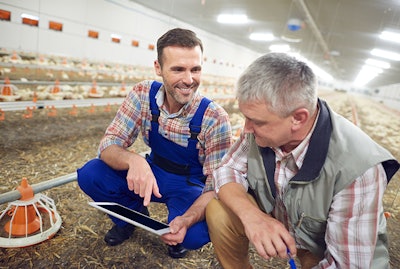
New technological advancements – like blockchain – promise to improve poultry operations and efficiency, however success relies on buy-in from all of the involved stakeholders.
During “Practical Approaches to Blockchain Adoption,” one of the TechTalks featured during the International Production & Processing Expo (IPPE) Marketplace, Kathy Barbeire, the Marketing Manager of Cat Squared, shared five practical steps to encourage the adoption of new technologies in food production.
Understand your process
First, Barbiere recommends developing a process map, which can provide users with a visual understanding of the processes that occur. This can help stakeholders better understand a new process – from the hardware used to how information is collected and recorded.
“Having a clear understanding of what data you are gathering and how it flows across your network helps you identify operational value drivers and develop measurable key performance indicators (KPIs) for data driven decision-making,” she explained.
Adopt common language and standards
“In order for blockchain and other digital technologies to be interoperable, common data standards much be adopted across the value chain,” Barbiere said.
EPCIS, which stands for electronic product code information services, is an open standard that helps businesses capture and share information about the movement of goods throughout the supply chain.
Within EPCIS, there are six standard event types:
- Commission: An event signifying the creation of an object. For example, the birth of chicks.
- Transformation: An event signifying an irreversible transformation of an object, like slaughtering chickens.
- Aggregation: An event signifying grouping of objects. For example, batching of the chickens for transformation.
- Disaggregation: An event signifying the ungrouping of objects into smaller groups or individual objects, like separation of the chickens.
- Observation: An event signifying an observation. This can include quality testing of the carcasses.
- Decommission: An event signifying deletion of an object. For example, this would apply to any carcasses that are discarded.
Build a culture of knowledge sharing
Create a culture in your organization that welcomes innovation and other changes that could improve operations and efficiency in poultry production and processing.
“Leadership and accountability matter. Regularly meet with your plant leadership and establish standards and best practices. Hold each other accountable,” said Barbiere.
Develop strategies to bring value to stakeholders
When thinking about adopting a new technology or process, make sure it is set up to benefit everyone involved along the value chain. Without that, it can be difficult to achieve buy-in.
“The very nature of this new technology requires collaborative thinking,” she explained. “A blockchain is only as its weakest link. If any supply chain partner doesn’t see value in adding an additional step or an additional cost to their process, they won’t participate.”
Develop approaches for consumer education
Ultimately, it doesn’t matter how efficient poultry operations become if consumers aren’t interested in purchasing the final product. Transparency can help consumers understand how their food is grown and processed.
“Take time to build trust,” Barbiere said. “Let consumers know that you care about their concerns for safety, sustainability and humane treatment.”
Read more from IPPE Marketplace.
Like what you just read? Sign up now for free to receive the Poultry Future Newsletter.

















